Galvanic Corrosion is the problem
When you have two different metals physically connected in seawater electrical current flows between them, essentially turning them into a battery. For that current to exist, one of the metals has to physically give up pieces of itself(metal ions) to create the electrons and feed the current. This process of metal deterioration through electrical activity is known as Galvanic Corrosion. Whether it’s your propeller(bronze or aluminum),or the metals on your prop shaft, rudders, outboard and sterndrives, Galvanic Corrosion can cause major and expensive damage if not controlled.
Sacrificial Anodes (Zincs) stop Galvanic Corrosion
To stop Galvanic Corrosion from destroying your underwater metals you would have to disrupt the process of your boats metals sacrificing themselves to the electrical current. The solution is to add a third metal into the equation, one that sacrifices itself to protect your precious underwater metals, that’s where Sacrificial Anodes come in. Sacrificial Anodes are metals that are quicker to give up pieces of themselves in order to protect your underwater metals, and are most commonly made from Zinc, as it is the best alloy for protecting boats in seawater – hence, boaters refer to Sacrificial Anodes as Zincs. We can’t stress enough how the proper installation and maintenance of your zincs is essential to the protection of your underwater metals – leaving depleted anodes to protect your boat, or even worse, not having any at all will only assure disaster.
How much Zinc to use
There are general rules of thumb when using zinc anodes to protect underwater metals, some say 1 to 2% anode coverage to surface area being protected. However, there are a lot of variables that factor into the effectiveness of your zinc anodes, salinity, temperature, pollution levels, stray current, and water flow play a big part in the depletion of your anodes. Usually, diligent monitoring of your sacrificial anodes through trial and error will let you know the right amount of zinc to use.
Beware of Over Zincing
Beware of using too much zinc. If you use too much zinc the anode will develop a crust, get fouled and stop working. Too much zinc may also cause over protection. Over protection on an aluminum hull or outdrive can also be destructive. Over protecting an aluminum hull can lead to Cathodic Disbondment, where the destruction of adhesion of antifouling paint may occur due to a cathodic reaction.
Installing Zinc Anodes Properly
Sacrificial anodes cannot be put just anywhere. There are some that believe you can mount a sacrificial anode anywhere or even attach it to a string and hang it over the side – They’re wrong! The further a zinc is from the metal it’s supposed to protect, the less effective it becomes. For a zinc anode to be effective you need clean metal-to-metal contact – either by mounting the zinc directly to the metal being protected or by connecting the two with a wire. When mounting a zinc directly make sure the surface is clean before mounting the anode to assure good electrical contact. A hanging anode can provide protection ONLY if it is connected by a wire to the metal being protected.
Do not paint your zincs. Bottom paint on a zinc anode will smother it so it cannot perform its duty, rendering it useless.
When to replace your zinc anodes
Salinity, temperature, pollution levels, stray current, water flow and other environmental variables have a major effect on the life of your zinc anodes, so it would be difficult to give a specific time frame. A good rule of thumb and our recommendation is to replace your zincs when they’ve depleted 50%. This assures you optimal performance.
Quality matters.
Make sure you’re protecting your investment by using high-quality anodes – use MIL-SPEC Standards. The MIL-A-18001 Zinc and MIL-A-24779 Aluminum alloys are the preferred choice of the US Military (owners of the Worlds largest Naval fleet) and you shouldn’t use anything less on your craft. At Sea Shield Marine we make the Highest-Quality sacrificial anodes, all of our anodes are made in the USA to MIL-SPEC Standards, are pressure die cast for better density and longer life, and are always designed for reliable performance and easy installation.
FACT: Sea Shield Marine was the first company to introduce MIL-SPEC Standard anodes to the Pleasure Craft Industry (learn our story)
Know your Zincs
Propellers
Propellers normally use a zinc collar anode for protection, either limited clearance or streamlined collars are preferred and mount to the shaft forward or rear of the propeller.
Seashieldmarine.com/Streamline_Collars
Seashieldmarine.com/Shaft_Anode_LineCutter
Outboard propellers use either a zinc ring or prop nut anode for protection.
Seashieldmarine.com/Prop_Nuts
Rudders and Trim Tab
Rudders and Trim Tabs are both protected with similar rudder button style anodes. Rudder Button anodes have a low profile dome shape and are streamlined to minimize drag and turbulence.
Seashieldmarine.com/Rudder_Trim_Tab_Anodes
Hull Plates
Boats with bonded electrical systems are usually fitted with one or more zinc plates that are bolted to the hull. The zinc plates, typically referred to as a Divers Dream Plate, are mounted using bolts that connect to electrical cables on the bonding circuit. Zinc plate anodes are also used on metal boats to protect the hull and need to be carefully monitored.
FACT: Sea Shield Marine invented and perfected the Divers Dream Plate and it’s one of our crowning achievements.
Seashieldmarine.com/Bolt_On_Anodes
Outdrives
Sterndrive and Outboards are made up of a mix of different metals making them high risk to galvanic corrosion. Most outdrives are fitted with multiple anodes covering everything from, trim tabs, rams, cavitation plates and more. We recommend referring to your owners manual for the proper type and location of your zincs. Zinc anodes for outdrives can usually be purchased as individual pieces or in kits.
Sea Shield Marine carries all anodes for the popular Mercury Mercruiser Alpha and Bravo series outdrives.
Seashieldmarine.com/Mercruiser_Anodes
Engine/Heat Exchangers
Heat exchangers are typically made with a copper alloy which makes them prone to corrosion. To help protect them most heat exchangers are outfitted with “pencil” zincs. Pencil zincs or engine anodes are located under a brass plug on the exchanger.
Seashieldmarine.com/Pencil_Zincs



